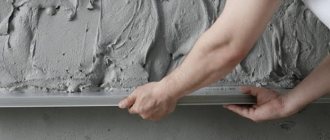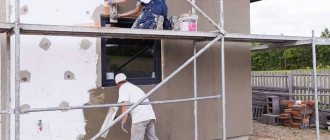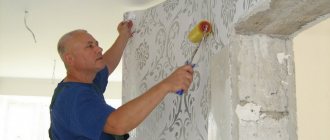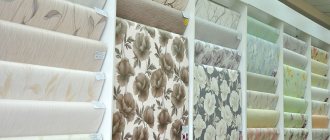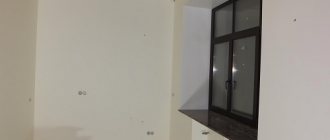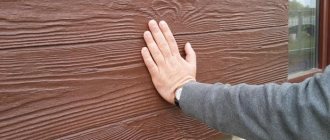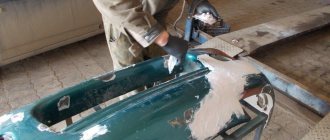The construction market has been offering cement-based putty as a coating for interior work for decades. It has proven itself to be a fairly strong, reliable and (you must agree, this is essential) durable coating. It is used for finishing the surface layer in any buildings, even in objects with excess moisture. It perfectly eliminates cracks, hides unevenness and many other surface irregularities.
Attention!!! It is important! The putty is very versatile. It interacts well with various types of surface bases: concrete, foam concrete, wood, cement.
Classification depending on the color of cement in the building mixture
The composition of cement putty, as the main active component, includes, of course, cement, as well as polymer additives and various types of mineral fillers. It is this composition that guarantees and makes it possible to create an ideal, smooth surface that does not require further processing. In addition, quartz sand has been added to the composition, which has a granular structure, which plays a decisive role in the intended purpose of the putty.
Types of putty
Putty (base – cement) for finishing walls and ceilings, depending on its components and scope of work, is divided into two large groups:
- Starting. The most important advantage of this type is the elimination of significant surface errors. As a rule, it is used in the initial stages of work to level the surface. The thickness of the applied layer is approximately 1.5-2 cm. This is facilitated by large particles of quartz sand (0.5-0.8 mm). For the final (finishing) layer, this type of putty is not appropriate (the large size of the quartz sand fractions), although the resulting layer is quite even.
- Finish. It is used at the final stages of work to give the surface a perfectly smooth state. The composition also contains quartz sand, but finer (0.2 mm). This type of putty is not able to hide fairly large cracks or irregularities.
Types of cement putties
This type of putty is created on the basis of cement, to which sand of various fractions is added as a filler. In addition, they contain additional polymer components responsible for improving the quality of the mixture - plasticizers, binders and antifreeze additives, etc.
Conditions for working with putty
Lay the putty in the warm season.
Cement-based putty is quite unpretentious to use, but when working with it you should still follow the recommended parameters.
So, when applying it to the surfaces to be treated, the following requirements must be observed:
- The air temperature should be from +5 to +30 degrees. Moreover, this temperature regime must be maintained until the solution has completely hardened, that is, for at least 3 days.
- Air humidity should not exceed 65 - 70%. After treating the external walls of buildings, the putty surface should be protected from possible precipitation to avoid washing out the cement.
Cement-based putties are divided into several types depending on their characteristics.
Filler fraction size
Finishing mixtures are used for final leveling.
Based on the size of the filler fraction - quartz sand, cement-based putties are divided into finishing and starting (also known as base).
Basic mixtures can be used for walls that have some cosmetic flaws: sinks, cracks, chips. In this regard, sand with a fairly coarse fraction - up to 0.8 mm - is used as a filler for them. This allows you to create better adhesion to the binding components (cement, polymers) and apply the solution in a sufficiently thick layer.
The maximum permissible layer of the starting composition can be 5 mm, which is quite enough to seal small defects in load-bearing surfaces.
Apply the finishing coat in a 2 mm layer
Cement finishing is intended for final leveling of the surface and obtaining a plane suitable for applying decorative finishing material. As a result, fine sand with a fraction diameter of no more than 0.2 mm is used in its production.
The finishing mixture is applied in a thin layer not exceeding 2 mm, creating even bases. But, despite the fine fraction of the filler, its size in cement-based finishing compositions is slightly higher than in mixtures created using gypsum or polymers (acrylic, latex). This is due to the minimum acceptable fraction size to obtain a strong adhesion of the filler to the cement.
If you need to get a perfectly smooth glossy surface, it is better to use gypsum or polymer putty compounds for this purpose.
Color
Gray mixtures are made from cement grades M-300 - M-500.
According to its color, cement putty can be:
- Gray.
- White.
- Super white.
Gray putty mixtures are made on the basis of ordinary Portland cement grade M-300 ... M-500. This is what accounts for their relatively dark colors. Gray putty is used mainly as a base putty, since the gray color of the treated surface can affect the shade of the finishing coat when painting or whitewashing the wall in light colors.
The cost of white cement mixtures is higher
White compositions are obtained using white cement as a binder. Its cost is noticeably higher than that of gray Portland cement, so white putty compositions are somewhat more expensive than gray ones.
White cement putty is used mostly as a pre-finish coating, directly intended for painting or other type of decorative finishing. White is a great neutral background that won't affect the color of the paint.
Superwhite cement putty is also made from white cement and quartz sand, but it also contains white pigments and polymers, which give the putty surface a perfectly white color. This mixture is used for walls intended to be painted with white paints. For a review of putties, watch this video:
Despite their higher cost, superwhite mixtures allow you to save on decorative finishing, since putty surfaces can be painted in one layer, so it is advisable to treat walls with superwhite putty if they are to be painted with high-end white paint.
Release form
The following division into types depends on the form of release:
- Dry. You can control the level of consistency, but it is very important to properly dilute the solution itself and then apply it to the surface without errors. Adheses very well to the base.
- Pasty. Available in plastic containers. The cost, of course, is higher for a similar, but dry mixture. Also, the builder is deprived of the ability to independently regulate the consistency of the mixture.
The color of the cement in the composition determines its category:
- gray mixture;
- white cement putty;
- super white composition.
Gray
Dry finishing gray putty contains cement, some mineral fillers and all sorts of functional additives. The mixture is quite moisture-resistant and plastic, very easy to apply and spread over the surface without much effort, and has very good adhesion to the application base.
It is used for rough leveling of the surface layer of ceilings and walls made of concrete or brick. Gray putty has proven itself well when carrying out interior (exterior) work on surfaces that are regularly exposed to moisture or temperature changes.
Cement white
White cement putty has good adhesion (the ability to firmly adhere to the applied surface material) to any mineral base and is weather-resistant. White putty is used to smooth out roughness, fill irregularities and cracks on concrete, cement and even lime-cement surfaces. Very easy to sand and paint. The maximum thickness of the applied layer can reach 30 mm.
Super white composition
The composition includes white cement, necessarily quartz sand, polymers and some pigments (ground marble), due to which the finished surface acquires a perfectly white, snowy color. When dissolved with water, a very plastic mixture is obtained, which, after hardening, forms a fairly strong frost-resistant and moisture-resistant layer. Can be applied to cement, concrete, reinforced concrete and cement-lime surfaces. Professionals recommend using this material only if you are finishing the room with bull paint. Why? The answer is obvious. This type of putty has a high price and this is its main drawback.
Brief overview of cement putty manufacturers
There are quite a few manufacturers of cement putties, but we can still highlight the most popular brands:
Vetonit VH
Finishing putty on white cement. Sold dry and suitable for exterior and interior decoration. Perfect for rooms with high humidity levels, swimming pools, bathrooms. For external use, this putty is suitable for finishing plinths, fences, and facade work.
This material is a joint production between Finland and Russia. Thanks to high-quality raw materials and careful control during production, cement putty of this brand has established itself as a reliable and profitable product.
Bolars waterproof
Cement putty made in Russia. The product is a starter product and is suitable for the initial treatment of uneven surfaces. Can be used for both external and internal work. Resistant to low temperatures. For interior decoration it is used for bathrooms, kitchens, as well as rooms with a high level of load - corridor, hall, living room. It is popular due to the fact that it can be applied in a thick layer - up to ten millimeters, which means it can level large differences in the surface at a time.
Kreps VL white
Cement finishing putty is also of domestic production. Moisture and frost resistant, has excellent strength characteristics. Can be used for manual and machine application. The maximum layer thickness is three millimeters, in some cases - with partial application - up to five millimeters. It is in great demand due to the most comfortable price-quality ratio.
Ceresit CT 225
Facade finishing putty based on gray cement. The main area of application is exterior decoration, but can also be used in “wet” rooms. It contains a special reinforcing fabric, which makes the dried layer of putty as durable as possible and resistant to cracking. Resistant to any weather conditions. Produced in Russia.
Advantages and disadvantages
Cement itself is a fairly strong, durable and reliable material, so building mixtures on this basis also have these qualities. The addition of a certain amount of modifying additives significantly increases the strength of dry putties.
Attention!!! It is important! Cement-based putties have excellent water resistance, so they are perfect for rooms with high humidity (bathroom, basement, kitchen, etc.). All types of putty (gray, white and super white) can easily withstand humidity levels of almost 96%.
The use of cement putty is often practiced not only for interior work, but also for facade finishing, as they flawlessly withstand any weather changes (snow, rain, ultraviolet radiation, frost). Also, do not forget that the material itself is an environmentally friendly substance, since it contains only natural and absolutely harmless ingredients. One of the advantages is the ability to create a perfectly smooth, extremely thin surface (1 mm and above). The advantage of this composition is the absence of shrinkage and cracking over time.
Among the disadvantages, it should be noted that cement-based putty interacts very poorly with various paints and varnishes. In other words, you should not mix cement putty with various varnishes, adhesives or paints, which can significantly change the performance properties of the original mixture.
You should also know that the entry of any foreign particles into the solution makes the prepared mass completely unsuitable for further use.
Pros and cons of cement putties
Like any finishing material, cement putties have their advantages and disadvantages. To successfully use this putty, it will be enough to know about them and apply the product accordingly to avoid trouble.
Pros:
- Easy to use. Cement putty, properly prepared from a dry mixture or already purchased ready-made, has a soft consistency and is easy to apply. Even an amateur in finishing work can work with it, not to mention those who have experience of this kind.
- Strength of cement. Cement, from which the putty is actually made, is one of the most durable and strong materials for sealing cracks and irregularities. The finishing layer obtained after drying will last unchanged for many years. It is well suited for uneven surfaces, as it can level out large differences - up to 15 millimeters it is quite capable.
- Cement putties are not afraid of frost, heat, and moisture. They are suitable for rooms without heating, bathrooms, kitchens, garages and at the same time, bedrooms and living rooms.
- Price. The cost of cement putties, along with their reliability, also guarantees their popularity in the finishing materials market. Since the main ingredient - cement - is not expensive, the putty itself is quite affordable for everyone.
The advantages are quite significant, which is why cement putties are mass produced and also purchased in large quantities.
Minuses:
Large granular structure. Even finishing putty made on a cement base has some graininess - this is due to the properties of its main component - cement, as well as quartz additives. That is, even the most expensive and high-quality cement putty will not leave behind that ideal smoothness that, for example, gypsum putty can provide.
There is no ideal whiteness. Even those putties that are made with white cement have a yellowish tint after drying. This finish is not suitable for painting, but if you plan to wallpaper the room, then in this case the shade is not a hindrance.
An important nuance: cement putties cannot be mixed with dyes, varnish, adhesives or anything else. If something accidentally gets into the finished mixture, it is unsuitable for use.
Type of work performed
The entire range of cement-based putty can also be divided according to the type of work performed:
- decorative;
- thermal insulation.
Decorative
The basis of this type of plasters is gray cement with the addition of colored ground clinker. When applying this type of putty, the texture and color of the main coating in most cases is determined by the finishing layer, which is explained by the rather high price of colored cement, in contrast to the classic gray color.
To add color effects and decorative texture, colored sand, lime or crushed rock particles are added to the mixture.
Thermal insulation
It is used for leveling and thermal insulation of building surfaces made of brick, concrete, aerated block masonry, ordinary cement or gypsum plasters. The composition contains special additives and lightweight filler (foam balls), which, having poor thermal conductivity, perfectly retains heat in the interior. Shelf life is approximately 3.5 years.
Main characteristics of the mixture
So, first let’s look at the advantages and disadvantages of this group of materials:
- The presence of cement in the composition gives it the highest reliability indicators: the finished coating is resistant to high humidity, is not afraid of temperature changes and practically does not change its performance properties under any conditions.
- The surface, after drying, has a very high hardness, while the cement prevents the appearance of cracks, which is why cement-based putty for exterior work has been the most popular in finishing facades for decades. All analogues with similar properties are much more expensive, so in the foreseeable future this option will remain the best solution.
- As noted above, one of the main advantages is the low price of the material - it belongs to the affordable segment.
- Simplicity of work - you can easily finish the walls with your own hands, and the quality of the coating will be at the highest level. You don’t need any special equipment for this; you can buy everything you need at any hardware store for a reasonable price.
- There is no need to study special literature; all the features of preparing the solution and its use will be described in the instructions present on each package with the mixture.
In the photo - standard packaging in 25 kg bags
- Do not forget that there are 2 types of compositions: starting and finishing; their main difference is the graininess of the fragments. So, starting mixtures include quartz sand with a size of 0.5 to 0.8 mm; such a mixture will perfectly level the wall, but the surface will be too rough. In finishing compositions, the particle size in the composition does not exceed 0.2 mm.
- Another important detail: the color of the composition depends on what kind of cement was used in production. If this was the usual option, then the resulting cover will be gray. And the use of white cement gives the finished composition a beige or yellowish tint, and it is much easier to paint it later.
Cement finishing putty has a yellowish tint
- It is not recommended to mix cement compositions with various adhesives, paints and other mixtures; this can significantly deteriorate the performance characteristics of the resulting surface to the point where you will have to carry out the repair again, so it is better not to experiment.
The disadvantages include the following:
- Still, even in finishing options the grain size is higher than in acrylic or latex putties. But this is absolutely not important when finishing facades, where the only alternative is polymer-based putty, the cost of which is several times higher.
- Many people do not like the yellowish color, but it is easily covered with paint, so this nuance is not particularly important and should not be paid attention to.
Formation of pricing policy depending on color
Color plays a decisive role in shaping the pricing strategy. The price of the compositions is quite high, so not all hardware stores can afford such a product.
Dry putty is sold in paper bags of 5-20(25) kg. If such large volumes of the mixture are not required, then you can always purchase putty pastes that are packaged in buckets.
Cost per sq. meter depends directly on the consumption of material, which is determined by the thickness of the application.
Attention!!! It is important! Remember that a square meter of plaster applied using the simplest technique costs much less than in an artistic style.
Colored putty
Very often, colored putty is understood as any decorative plaster. First of all, this is any type of decorative coating, although there is still some division into groups:
- Available ready-made and only in a certain color. For example, the color of mosaic plaster is determined by the presence and color of its granules, since the color pigment must match the shade of the stone component;
- the next group is produced in the form of a white or gray mass, which is then tinted. These are, as a rule, textured polymer-based plasters. Different amounts of added pigment make it possible to obtain a solution of various colors.
Application of finishing putty
Wall Defect
Finishing putty is applied to prepare walls or ceilings for painting, wallpapering or cladding. It is used not only for leveling surfaces, but also for eliminating various defects.
The material is sold in powder form, from which you need to make a solution yourself. It is recommended to store powdered putty in its original packaging in a dry place.
Cement putty is often used for finishing kitchens, bathrooms and other rooms with high humidity, as well as for external facade work.
It is applied to walls or ceilings, and then used as a base for tiles, paint, wallpaper or decorative plaster. This material is well painted with paints based on organic solvents, as well as water-based and powder paints.
Finishing putty is also used in other cases, for example, it is applied to foam concrete and drywall, although their surface is quite flat. The fact is that these materials are capable of absorbing moisture; they are protected from the effects of water using reliable cement putty.
Recommendations for selection
When purchasing, pay attention to the brand of cement and quartz sand in the composition. The granularity of the coating depends on the size of the particles, and a poor-quality cement composition will result in cracking of the surface layer with its subsequent crumbling.
Gray is better suited for rough leveling the surface, but for finishing work the ideal option is white or super white putty.
Experts recommend dry mixtures in bags, as they can provide 100% strength to the applied base. But it is not advisable to use ready-made mixtures.
Features of the work
In order for the surface to be reliable and of high quality, it is necessary to comply with all the requirements of the technological process, which is divided into several main stages.
Surface preparation
As with other types of compositions, when using these mixtures, you need to carefully prepare the base:
- The surface must be dry, clean, without any sagging or unevenness. If there are cracks and areas with deteriorating material, it must be removed, and all problem areas must be sealed with cement mortar or tile adhesive; it also has sufficient strength. Naturally, you need to wait until the solution dries before proceeding with further work.
All irregularities are sealed with cement mortar
- Next, the walls are treated with a special deep penetration primer, which strengthens the surface, reduces the absorption of loose areas and significantly improves the adhesion of finishing compounds. Application should be done in dry weather to allow the layer to dry without exposure to water.
Advice! For exterior work, you can use primers with the addition of quartz particles. Thanks to them, the putty applies much better and is attached much more firmly.
You can prime the façade with a paint brush or roller, this way you will ensure that the composition penetrates into all uneven areas.
Putty work
After preparing the base, you can begin the main work, which is carried out in several stages:
- First, finishing is carried out with the starting composition, which is easiest to do using two spatulas - narrow and wide and a metal grater. With their help, work will be done quickly and easily. The composition is convenient to use within 1-2 hours, so you should not knead too much to avoid its hardening.
- Next, a cement-based finishing putty is taken and the wall is coated a second time. At this stage, you should try to make the surface as carefully and scrupulously as possible - this will simplify further work.
- The final stage of finishing is grinding the surface, which completely levels it. The work is quite simple, and you can handle it without any problems.
Remember! Until the composition hardens, it should be protected from exposure to water and, if necessary, covered with oilcloth until completely hardened.
Cement-based putty allows you to remove even the most complex structures
